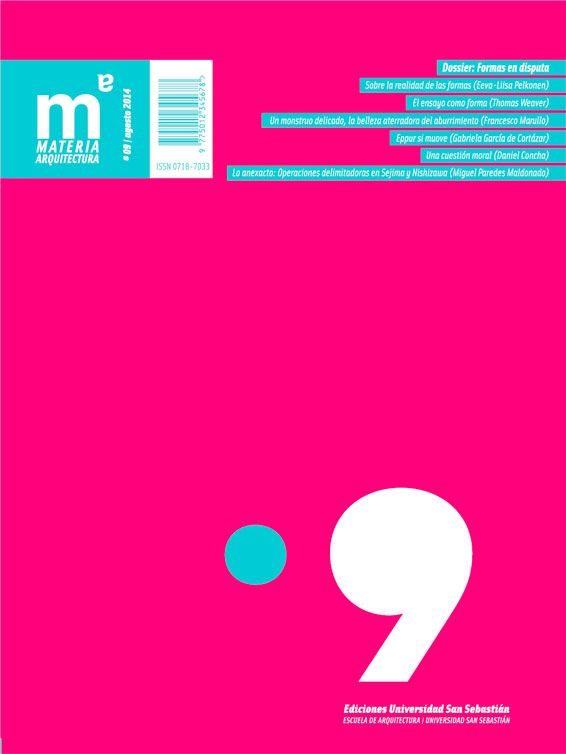On the Actuality of Forms
Barra lateral del artículo
Palabras clave:
Contenido principal del artículo
Resumen
The essay discusses some of the techniques Josef Albers, the famous artist-educator, employed in his own work and in his teaching
to make form activate the mind of the creator. The concept “actual,” which Albers used to draw a distinction between two types of
knowledge, “factual facts” (passive) and “actual facts” (active), is used to describe forms that triggered innovation. The essay makes
the point that Albers was not in search for the exceptional, but preferred forms that were ordinary, even banal, bearing resemblance to things that people encountered on an everyday basis. Some of his legendary teaching assignments in his color and free-hand drawing classes, as well as his "Homage to the Square" series, are discussed as examples of how he aimed at snapping students and himself out of the bond between form and meaning, and, in so doing, opening form to multiplicity of experiences and interpretations. In conclusion, that essay situates Albers ideas about how art is made and experienced within 19th and 20th century intellectual culture and speculates about its relevance for today’s architecture. Main references include Federick A. Horowitz and Brenda Danilowitz Josef Albers: To Open Eyes and period articles by Josef and Anni Albers.
Detalles del artículo
Materia Arquitectura proporciona acceso inmediato y gratuito a todos los contenidos de esta edición electrónica, publicada simultáneamente con la edición impresa. Materia Arquitectura no cobra honorarios a los autores por ningún concepto.
Todos los contenidos de esta edición electrónica se distribuyen bajo licencia Creative Commons de “Atribución-Copartirigual 4.0 Internacional” (CC-BY-SA).
La licencia Creative Commons permite el acceso libre e inmediato al contenido y permite que cualquier usuario lea, descargue, copie, distribuya, imprima, busque o genere enlaces a los textos completos de los artículos, permitiendo también que estos puedan ser rastreados para indexarlos, pasarlos como datos a software o usarlos para cualquier otro propósito legal. Asimismo, la licencia otorga derechos de uso a quienes a su vez utilicen una licencia abierta (Creative Commons o equivalente).
Los derechos de los textos y las imágenes publicadas pertenecen a sus autores, quienes otorgan a Materia Arquitectura la licencia para su uso. La gestión de los permisos y la autorización de publicación de las imágenes (o de cualquier material) que contenga derechos de autor y sus consecuentes derechos de reproducción en esta publicación es de exclusiva responsabilidad de los autores de los artículos.
Toda vez que mencionen su origen, los autores son libres de distribuir sus artículos por otros medios. Cualquier reproducción total o parcial del material deberá citar su procedencia.
Descargas
Citas
ALBERS, J. (1934). Concerning Art Instruction. Black Mountain College Bulletin 2.
ALBERS, J. (1969). One Plus One Equals Three and More: Factual Facts and Actual Facts. En J. Albers, Search versus re-search: three lectures by Josef Albers at Trinity College, April 1965. Hartford, EE.UU.: Trinity College Press.
ALBERS, J. (2013). Interaction of Color. 50th anniversary edition. New Haven, EE.UU.: Yale University Press.
HOROWITZ, F. A., & DANILOWITZ, B. (2006). Josef Albers: To Open Eyes. Londres: Phaidon.
MERTINS, D. (2004). Bioconstructivism. En L. Spuybroek (Ed.), NOX: Machining Architecture (págs. 360-369). Londres: Thames & Hudson.
PELKONEN, E. L. (2012). Toward Cognitive Architecture. En S. von Moos, & J. Eisenbrandt (Eds.), Louis Kahn: The Power of Architecture (págs. 133-148). Weil-am-Rhein: Vitra Design Museum.
WINCKELMANN, J. J. (1765). Reflections on the Painting and Sculpture of the Greeks. Londres: A. Millar on the Strand.
Artículos más leídos del mismo autor/a
- Eeva-Liisa Pelkonen, Sobre la realidad de las formas , Materia Arquitectura: Núm. 09 (2014): Materia Arquitectura 09 (Agosto/August 2014)
